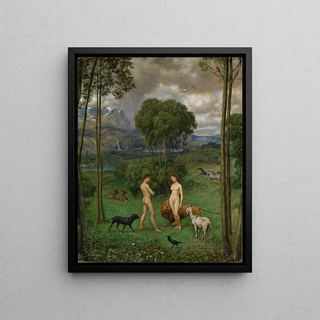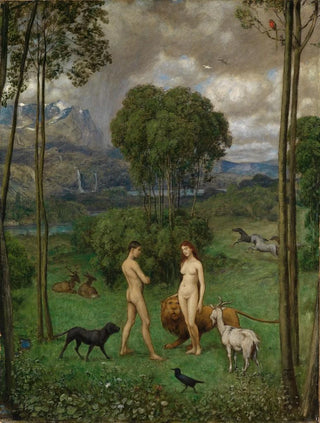Art print | In Paradise - Hans Thoma


View from behind

Frame (optional)
In the vast panorama of art history, certain works stand out for their ability to evoke deep emotions and transport the viewer into a dreamlike universe. "Au paradis" by Hans Thoma is one of these creations. This canvas, imbued with mystery and serenity, invites meditative contemplation. By immersing oneself in this painting, the viewer is instantly transported into a world where nature and the human spirit meet, a place where harmony reigns supreme. Thoma manages to capture a universal essence of peace, an echo of the utopia that everyone aspires to reach. Through this artwork, he reminds us of the importance of the connection between man and his environment, a timeless theme that still resonates today.
Style and uniqueness of the work
Hans Thoma's style is often characterized by his symbolist approach and his palette of delicate colors. In "Au paradis," he uses soft, soothing hues that evoke the light of a summer morning. Organic shapes and human figures intertwine in a harmonious ballet, creating a dreamlike atmosphere. Every detail, every nuance of color, seems carefully thought out to contribute to the overall composition. The composition is both balanced and dynamic, inviting the eye to explore the different layers of the scene. The characters, although stylized, exude an emotional depth that allows the viewer to identify with them. Thoma succeeds in creating a space where the viewer can project their own dreams and aspirations, making the work all the more powerful and personal.
The artist and his influence
Hans Thoma, born in 1839, is often regarded as one of the masters of German symbolism. His career, rich and varied, was marked by an incessant quest for beauty and truth. Thoma was influenced by his contemporaries, but he also developed a style that is uniquely his own, blending tradition and innovation. His interest in folkloric and mythological themes is reflected in "Au paradis," where he draws from ancestral stories to create a work that transcends time. The artist was able to capture the spirit of his era while remaining faithful to his vision

Matte finish

View from behind

Frame (optional)
In the vast panorama of art history, certain works stand out for their ability to evoke deep emotions and transport the viewer into a dreamlike universe. "Au paradis" by Hans Thoma is one of these creations. This canvas, imbued with mystery and serenity, invites meditative contemplation. By immersing oneself in this painting, the viewer is instantly transported into a world where nature and the human spirit meet, a place where harmony reigns supreme. Thoma manages to capture a universal essence of peace, an echo of the utopia that everyone aspires to reach. Through this artwork, he reminds us of the importance of the connection between man and his environment, a timeless theme that still resonates today.
Style and uniqueness of the work
Hans Thoma's style is often characterized by his symbolist approach and his palette of delicate colors. In "Au paradis," he uses soft, soothing hues that evoke the light of a summer morning. Organic shapes and human figures intertwine in a harmonious ballet, creating a dreamlike atmosphere. Every detail, every nuance of color, seems carefully thought out to contribute to the overall composition. The composition is both balanced and dynamic, inviting the eye to explore the different layers of the scene. The characters, although stylized, exude an emotional depth that allows the viewer to identify with them. Thoma succeeds in creating a space where the viewer can project their own dreams and aspirations, making the work all the more powerful and personal.
The artist and his influence
Hans Thoma, born in 1839, is often regarded as one of the masters of German symbolism. His career, rich and varied, was marked by an incessant quest for beauty and truth. Thoma was influenced by his contemporaries, but he also developed a style that is uniquely his own, blending tradition and innovation. His interest in folkloric and mythological themes is reflected in "Au paradis," where he draws from ancestral stories to create a work that transcends time. The artist was able to capture the spirit of his era while remaining faithful to his vision






